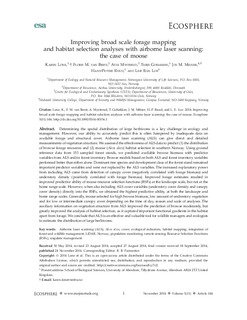| dc.contributor.author | Lone, Karen | |
| dc.contributor.author | van Beest, Floris M. | |
| dc.contributor.author | Mysterud, Atle | |
| dc.contributor.author | Gobakken, Terje | |
| dc.contributor.author | Milner, Jos M. | |
| dc.contributor.author | Ruud, Hans-Petter | |
| dc.contributor.author | Loe, Leif Egil | |
| dc.date.accessioned | 2015-02-20T08:49:01Z | |
| dc.date.available | 2015-02-20T08:49:01Z | |
| dc.date.issued | 2014 | |
| dc.identifier.citation | Lone, K., van Beest, F., Mysterud, A., Gobakken, T., Milner, J. M., Ruud, H.-P., & Loe, L. E. (2014). Improving broad scale forage mapping and habitat selection analyses with airborne laser scanning: the case of moose. Ecosphere, 5(11). doi: 10.1890/ES14-00156.1 | nb_NO |
| dc.identifier.uri | http://hdl.handle.net/11250/276843 | |
| dc.description.abstract | Determining the spatial distribution of large herbivores is a key challenge in ecology and management. However, our ability to accurately predict this is often hampered by inadequate data on available forage and structural cover. Airborne laser scanning (ALS) can give direct and detailed measurements of vegetation structure. We assessed the effectiveness of ALS data to predict (1) the distribution of browse forage resources and (2) moose (Alces alces) habitat selection in southern Norway. Using ground reference data from 153 sampled forest stands, we predicted available browse biomass with predictor variables from ALS and/or forest inventory. Browse models based on both ALS and forest inventory variables performed better than either alone. Dominant tree species and development class of the forest stand remained important predictor variables and were not replaced by the ALS variables. The increased explanatory power from including ALS came from detection of canopy cover (negatively correlated with forage biomass) and understory density (positively correlated with forage biomass). Improved forage estimates resulted in improved predictive ability of moose resource selection functions (RSFs) at the landscape scale, but not at the home range scale. However, when also including ALS cover variables (understory cover density and canopy cover density) directly into the RSFs, we obtained the highest predictive ability, at both the landscape and home range scales. Generally, moose selected for high browse biomass, low amount of understory vegetation and for low or intermediate canopy cover depending on the time of day, season and scale of analyses. The auxiliary information on vegetation structure from ALS improved the prediction of browse moderately, but greatly improved the analysis of habitat selection, as it captured important functional gradients in the habitat apart from forage. We conclude that ALS is an effective and valuable tool for wildlife managers and ecologists to estimate the distribution of large herbivores | nb_NO |
| dc.language.iso | eng | nb_NO |
| dc.publisher | ESA | nb_NO |
| dc.relation.uri | http://www.esajournals.org/doi/pdf/10.1890/ES14-00156.1 | |
| dc.subject | Airborne laser scanning | nb_NO |
| dc.subject | Alces alces | nb_NO |
| dc.subject | ecological indicators | nb_NO |
| dc.subject | habitat mapping | nb_NO |
| dc.subject | population monitoring | nb_NO |
| dc.subject | Resource Selection Functions | nb_NO |
| dc.subject | ungulate management | nb_NO |
| dc.title | Improving broad scale forage mapping and habitat selection analyses with airborne laser scanning: the case of moose | nb_NO |
| dc.type | Journal article | nb_NO |
| dc.type | Peer reviewed | nb_NO |
| dc.source.volume | 5 | nb_NO |
| dc.source.journal | Ecosphere | nb_NO |
| dc.source.issue | 11 | nb_NO |
| dc.identifier.doi | 10.1890/ES14-00156.1 | |
